Monts Groulx/Uapishka, Part 1
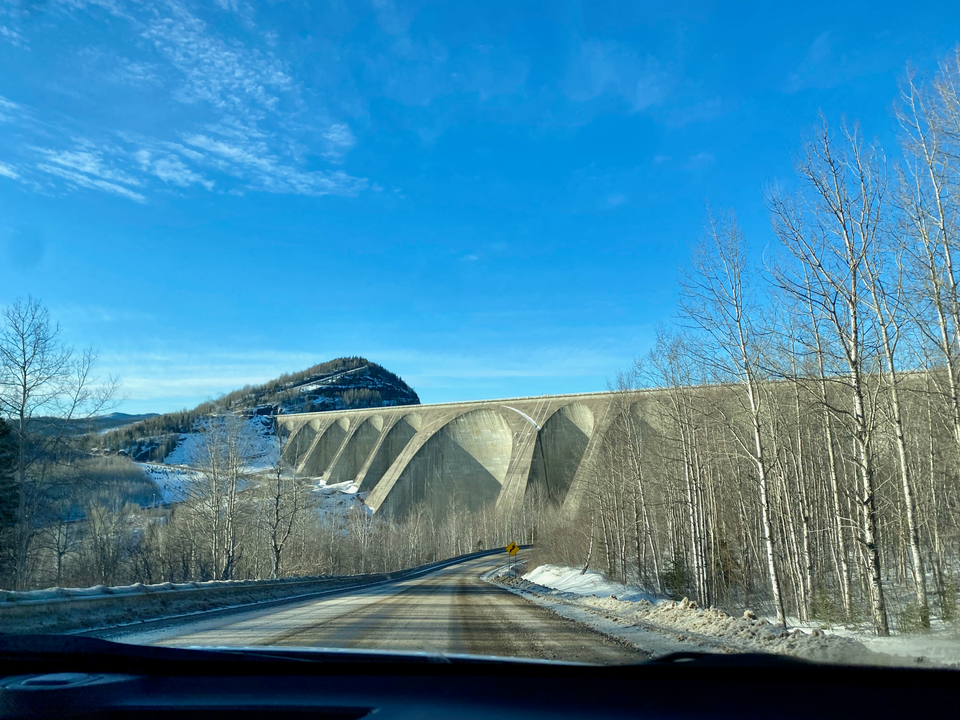
Well-planned adventures are rewarding. It’s very satisfying when all the pieces fall into place and the plan goes off without a hitch. Sometimes, this doesn’t happen, and you have to improvise, but the trip eventually gets back on track. Other times, improvising isn't enough; Murphy’s Law rears its head, everything goes wrong, and you are forced to embrace the chaos. In the end, these adventures are often the most memorable.
The Manicouagan Reservoir, known as the “Eye of Quebec”, is a circular lake 100km in diameter about 12 hours north of Montreal. It’s located in a massive crater formed by a meteor impact about 214 million years ago, the sixth-largest on record. The lake is adjacent to the Monts Groulx/Uapishka, a range of low mountains reaching 1104m at their highest point. Their name in the Innu language, “Uapishka”, means "always snowy rocky peaks" or "several white mountains". Because of their remoteness and the language barrier, this alpine paradise is almost unknown outside Quebec.
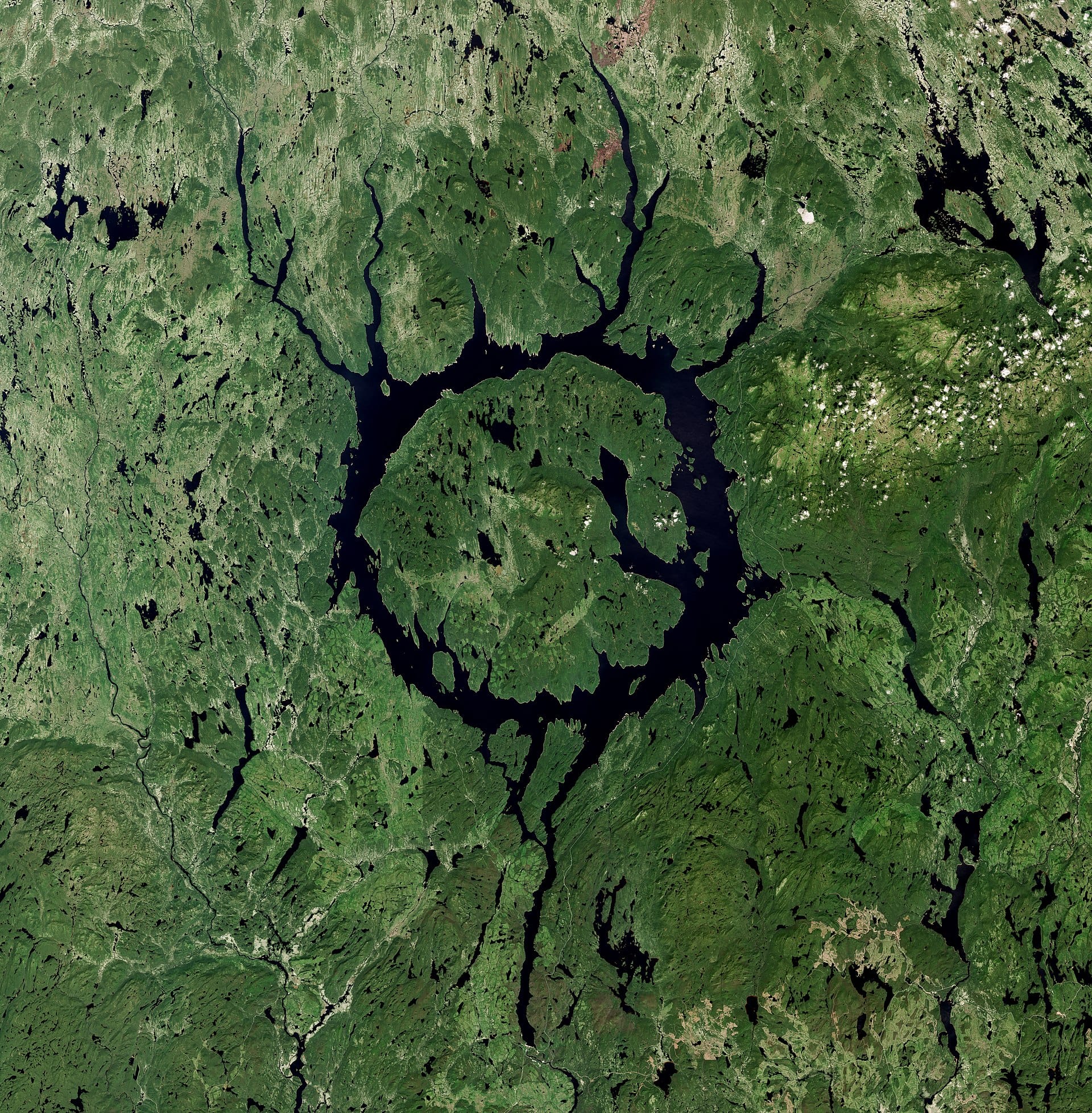
I joined a trip organized by Y. and M. from the McGill Outdoors Club (MOC) that aimed to explore the Eye over reading break. The plan was to drive to the mountains, spend a few days camping and hiking on the slopes of Mont Harfang, then stay in cabins at Station Uapishka, hopefully catching a glimpse of the northern lights.
A very chaotic week followed, including snowstorms, hitchhiking, floods, ice, broken equipment, delays, and more.
(If you’re only here for beta/trail info for the Monts Groulx, feel free to skip to Part 2).
March 3, 2024
I woke up bright and early to meet the group on the McGill campus. Within five minutes of leaving my apartment, I received my only traffic ticket in over six years of driving, setting the tone for the rest of the trip. On campus, I met the rest of the group and we loaded our supplies into the cars. The group consisted of 12 students and graduates of varying ages and experience levels. I hadn't joined a trip of this size since high school, but we got along well and I had a good feeling about the trip.
We then drove north to Quebec City, stopping for a while to charge M.’s Tesla. Lunch was eaten at a McDonalds with some of the worst reviews I‘ve seen, but the food was pretty much the same as anywhere else. We then drove another two hours north to Saguenay, pausing to regroup (one car was off on a side quest) and charge the Tesla again.
The other car arrived, carrying most of our food, including several blue bags of potato chips obtained through a food waste reduction app. Alarmingly, they were ranch-flavoured, instead of the salt and vinegar chips we had assumed they were. None of us had tried ranch-flavoured chips before and I am not eager to repeat the experience. We had at least ten bags of the stuff and they would haunt us for the rest of the trip.
Around sunset, we headed east along the Fjord du Saguenay, arriving at our planned campsite near Tadoussac. It turned out not to be suitable for camping, and the Tesla’s alarm was unintentionally activated, alerting the neighbours, who did not approve. We quickly got out of town. Even this far north, there weren’t many good winter camping sites, stealth or otherwise; all forest service roads were gated or iced over, and all official campsites were closed for the season. Along we went up the coast, stopping at other potential campsites like the beach near Les Escoumins, but camping was clearly not allowed anywhere.


As a last resort, someone suggested a supermarket parking lot in the town of Baie-Comeau. Given the late hour and sleep deprivation, we agreed. After we arrived, the police were called, but they left when we explained that we’d leave early the next morning.
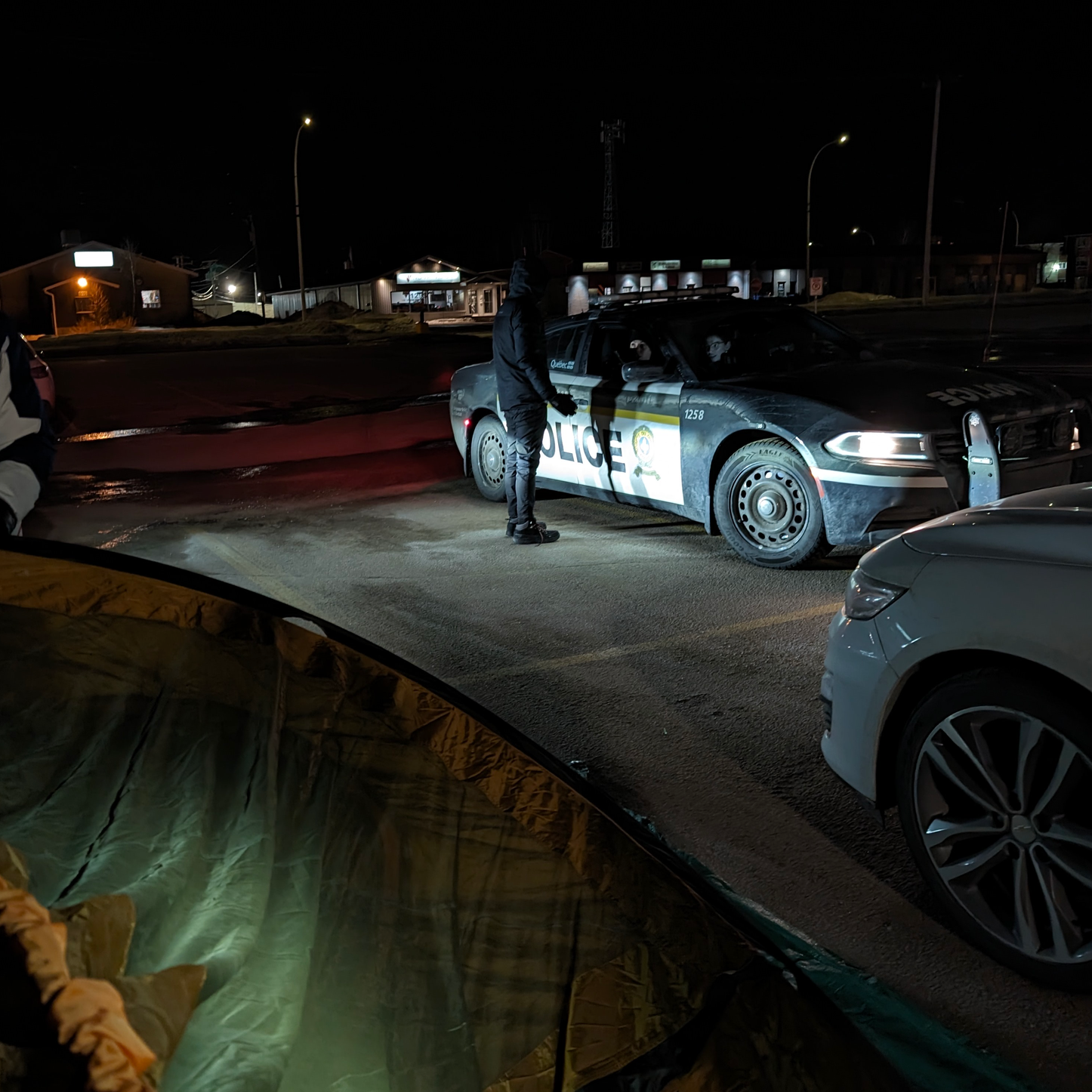
March 4, 2024
The tents were comfortable, except for the cold, and the wind, and some jackass who kept honking his horn and yelling racial slurs at 3 a.m. I guess there isn’t much to do in Baie-Comeau on a Sunday night. After an early wake-up and a couple hours of logistics, we drove off on Highway 389, which starts at Baie-Comeau and continues through rolling hills past the Eye to the Labrador border. The road was almost empty and we saw barely any other cars. Despite this, the road was paved, and in excellent shape; in Quebec, the roads get better as you go north.
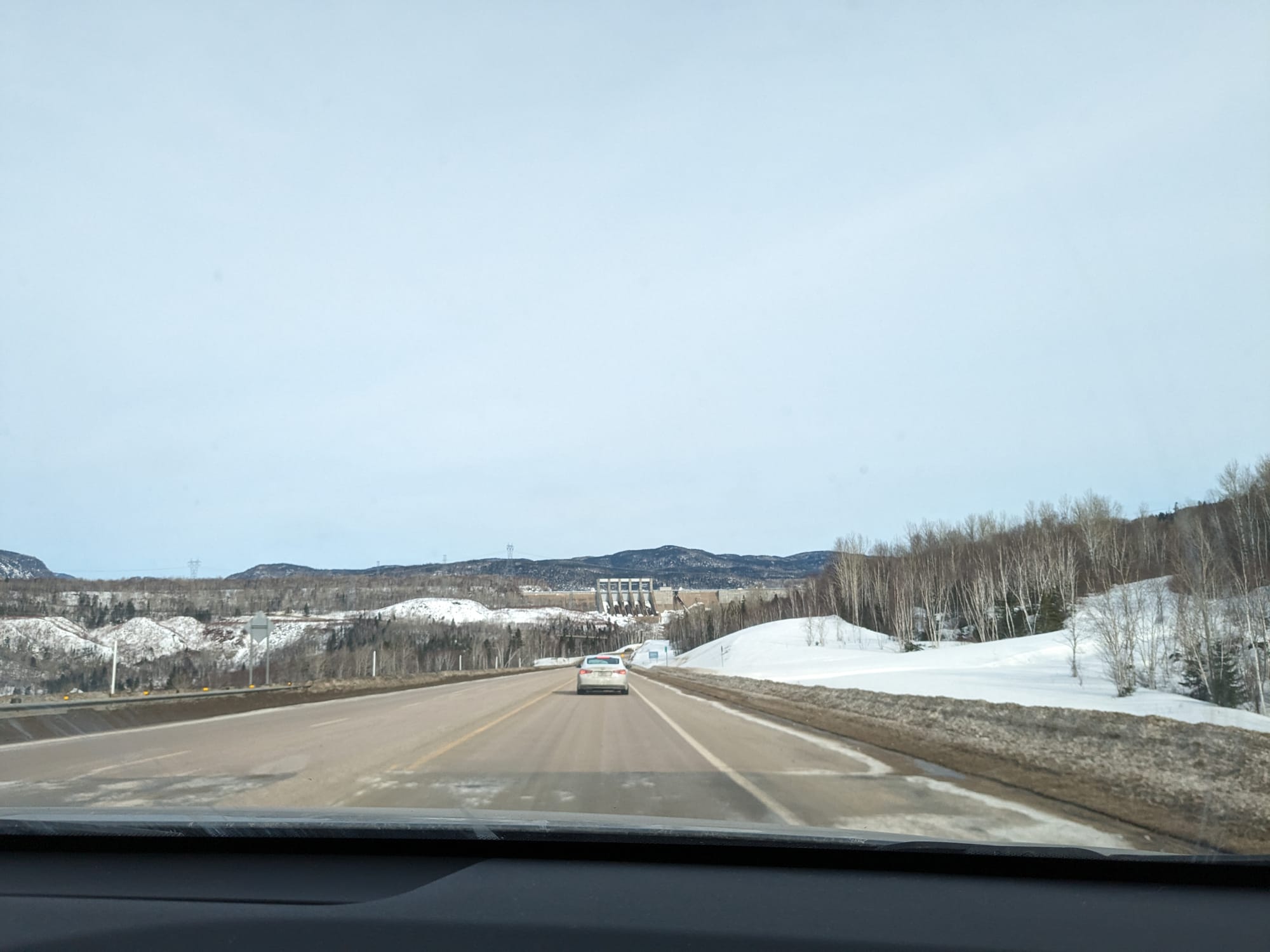
We passed several hydroelectric dams, which provide a large percentage of Quebec’s electricity: Manic-1, Manic-2, Manic-3, and Manic-5 (there is no Manic-4). Each dam was separated by vast expanses of boreal forest. Around 12:30, we arrived at the awe-inspiring Manic-5 dam, the largest multiple-arch buttress dam in the world. It was striking to see such a massive wall somewhere this remote.

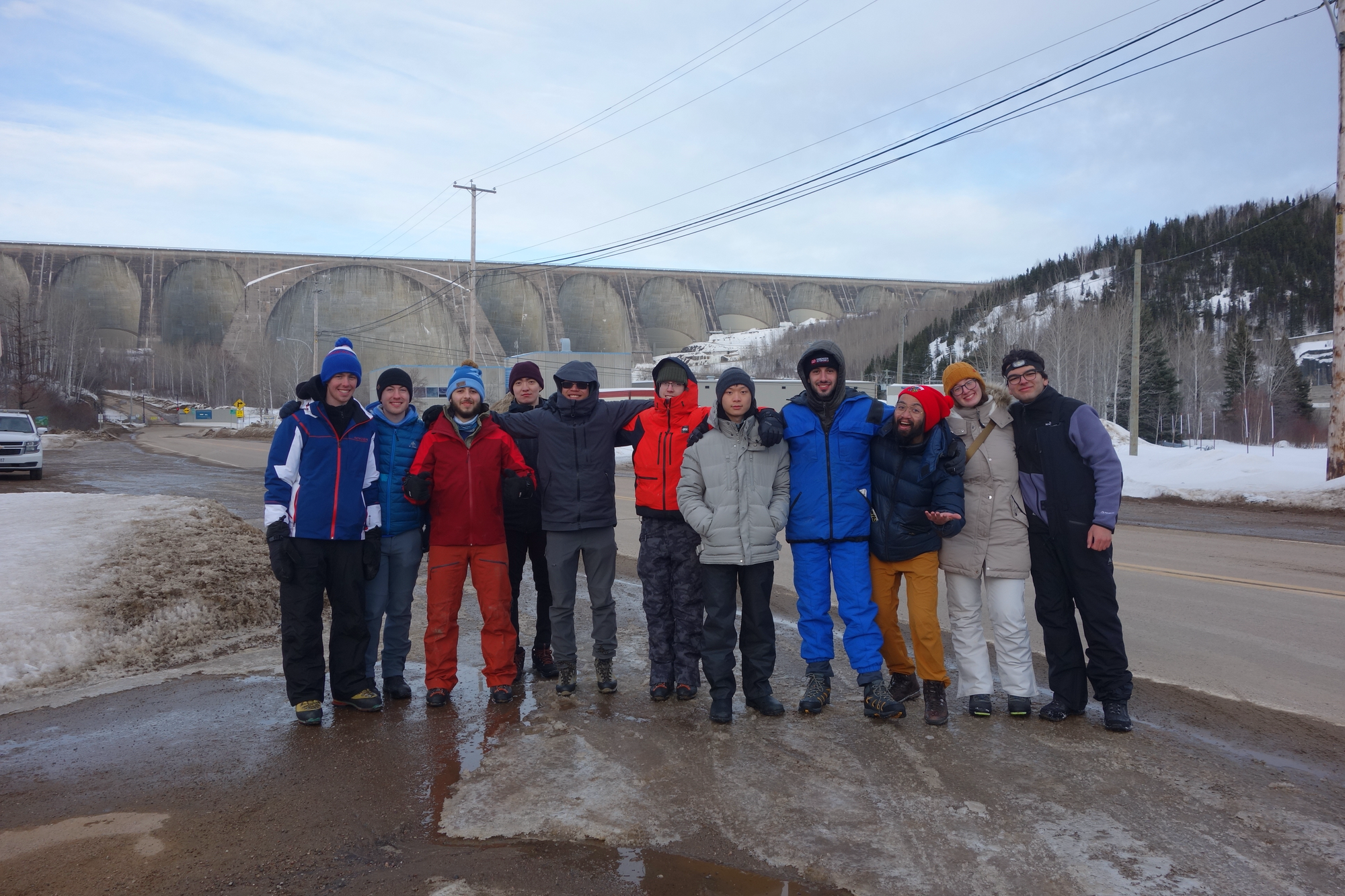
We stopped to give the Tesla some freshly made electricity, but despite being so close to the source, the charger wasn’t working. Someone from Hydro-Quebec stopped by to help, and eventually got it to work, but the car still took several hours to charge and charging stopped at random times.
It became apparent that we wouldn’t have the charge to leave Manic-5 anytime soon. Also, after last night’s cold temperatures, several people were concerned about camping somewhere as remote as Mont Harfang in colder conditions. This was several people's first winter camping experience. On top of this, the Tesla's driver was not aware that the road wasn't paved for the next 100km. A long and heated discussion ensued; we decided to stay in the Manic-5 area for the night and re-assess the next day.
One group went on a side quest to locate Hydro-Quebec workers and ask if we could camp near the dam. We weren’t allowed, but the workers kindly pointed us towards a spur road about 1km south where we could camp. It even had a viewpoint! The rest of us made a nice hearty pasta dinner.
While cooking dinner, one stove broke, and we discovered that the other two stoves had much less fuel than expected. This was a concern.
After sunset, a fox emerged from the forest and kept watching us. Someone had clearly been feeding him. Y. named him Dinner Special.
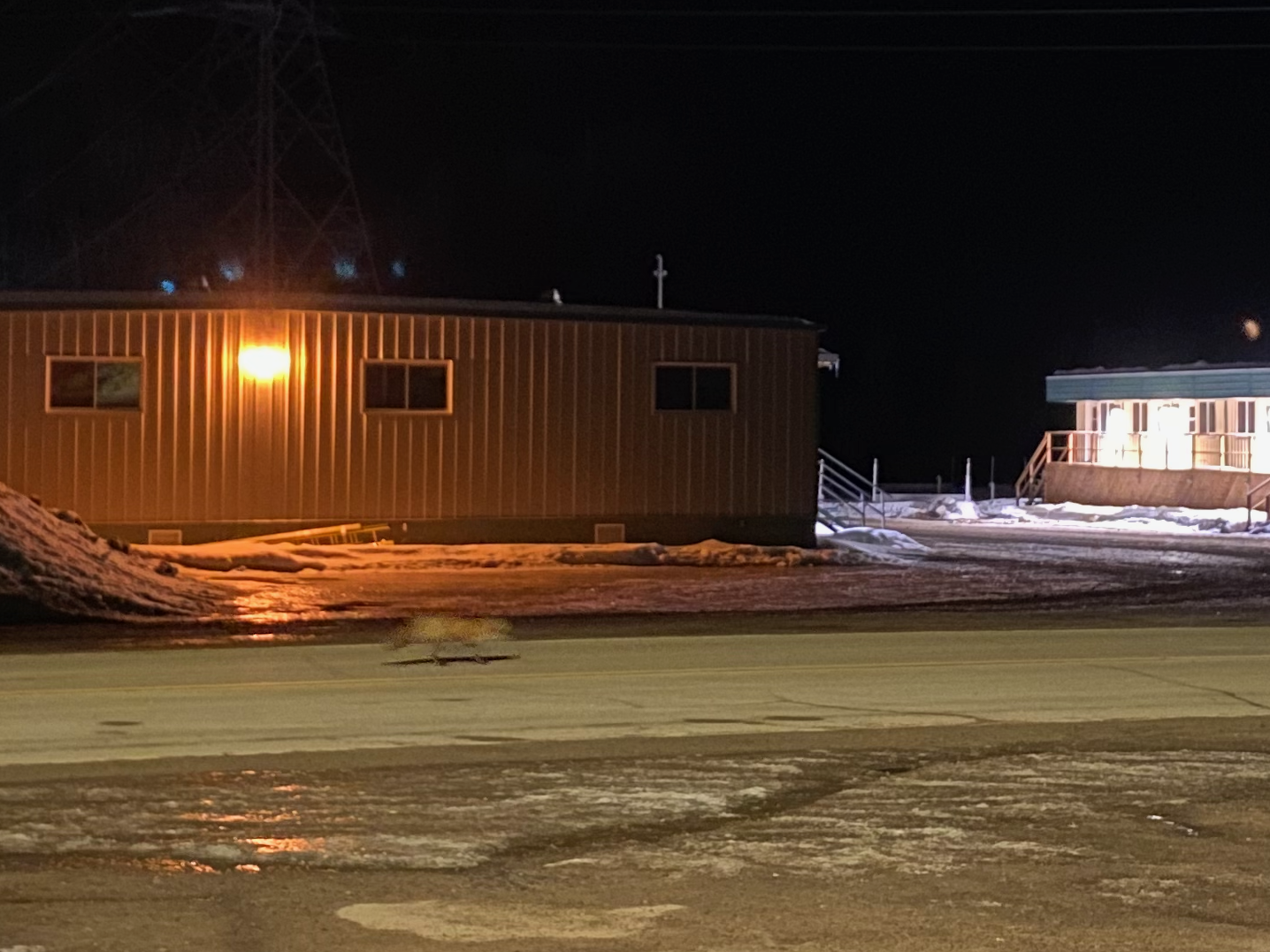
The spur road was covered in ice and rose up at a slight incline, but it was gentle enough for us to set up tents. The other drivers and I shuttled people back and forth between the parking lot and the tents. Someone had parked a snowmobile trailer next to the entrance, so we ran the gauntlet up the icy road between the trailer and the snow bank.
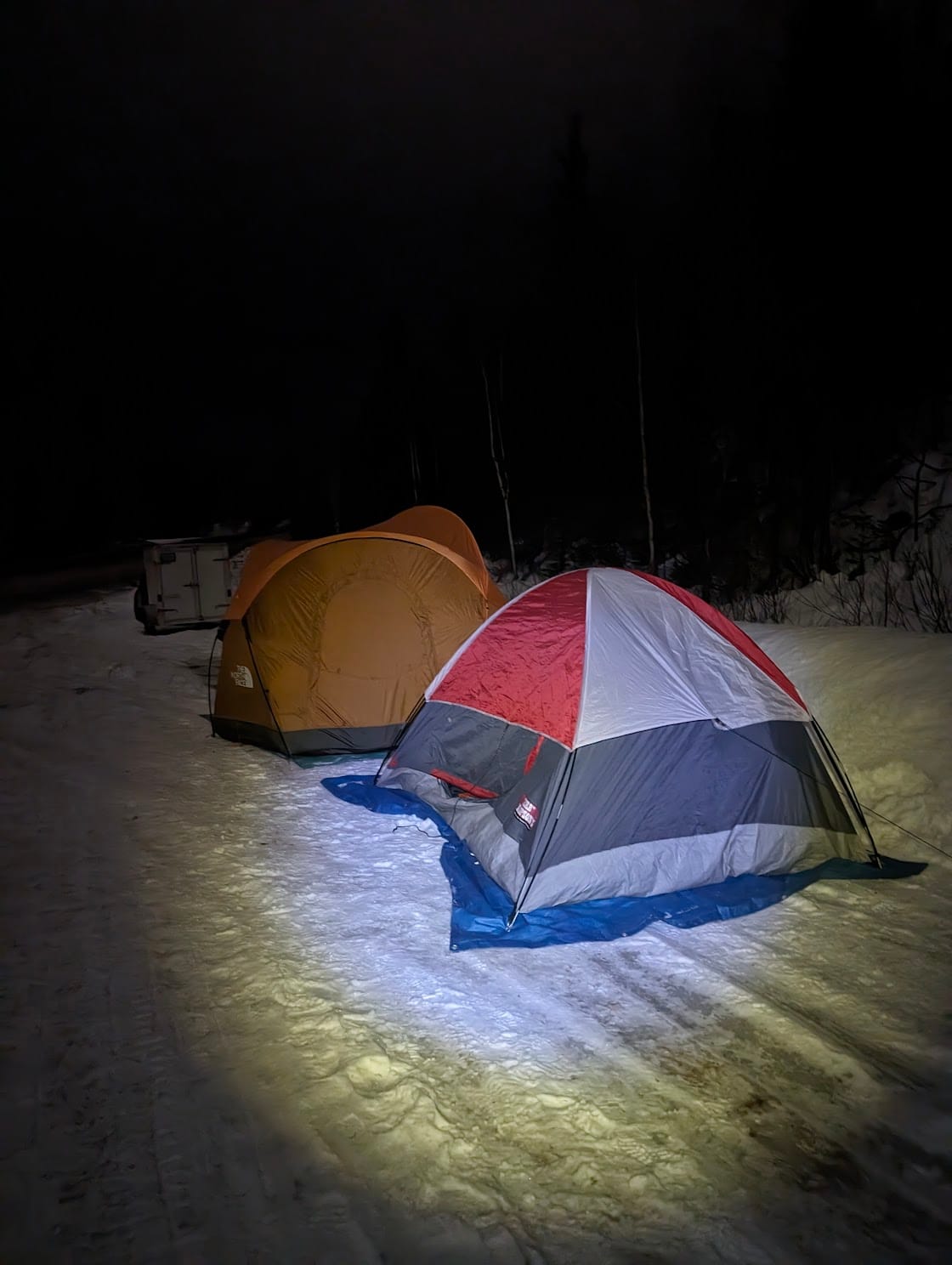
The dam was lit up at night, which was very impressive. Very few non-Hydro-Quebec workers get to see that in the winter!
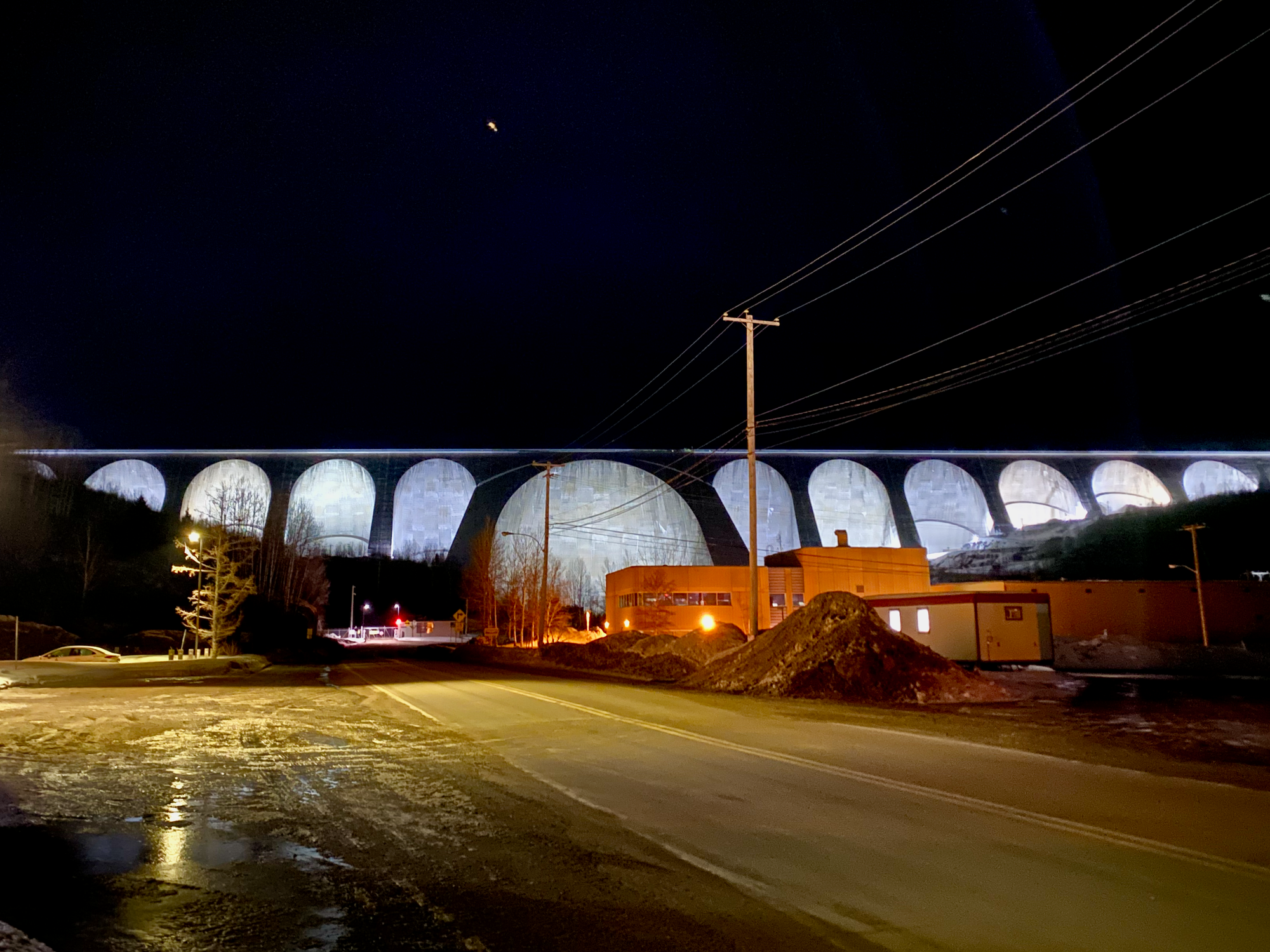
March 5, 2024
Today was an unseasonably warm cloudy day. After breakfast I drove a few people to the gas station at Motel de l’Energie, 2km south, for washrooms and snacks. While there, we checked the weather forecast, which was now showing rain in the afternoon, and below-freezing temperatures in the evening. The road would be extremely icy. This, in addition to the fact that the next 100km after Manic-5 is not paved, made it impossible for our cars to venture further. We began coming to terms with an extended stay at Manic-5.
There isn’t much to do around Manic-5 besides the dam and the viewpoint. Hydro-Quebec runs tours of the generating station, but only during the summer. Motel de l’Energie has a motel, gas station (with very helpful staff), and restaurant, but nothing else. The next town to the south is Baie-Comeau 4 hours away. Driving north was off-limits for now.
Some people went to scout out a potential campsite, finding a nice spot at the mouth of the Rivière Anita, on the other side of the bridge from the spur road. From the highway, a short but steep walk takes you to a somewhat flat area next to a rocky beach created by rising and falling water levels (as we would discover later). We moved our gear there, set up a tarp, and hunkered down for an extended stay. Once the tarp was up, the rain began, and soon most of us were soaked.
On another trip to the gas station, the helpful cashier and several passing truckers told us that the road was indeed very icy, and that it was actually closed past Relais-Gabriel (100km north of Manic-Cinq, 21km south of our destination). It seemed like our cars would never make it past Manic-Cinq, especially since only one had four-wheel drive. Some of us came up with an intriguing plan: we would leave the cars at the parking lot past the dam, split into four groups, and hitchhike to the station. It would be most people’s first time hitchhiking and we were excited about the idea.
The afternoon was mostly spent at camp, with a side quest to scout out the dam and test out the Tesla’s built-in light show. Anything off the main road was very icy. Z. went for a 12km hike along the road and could not be stopped.
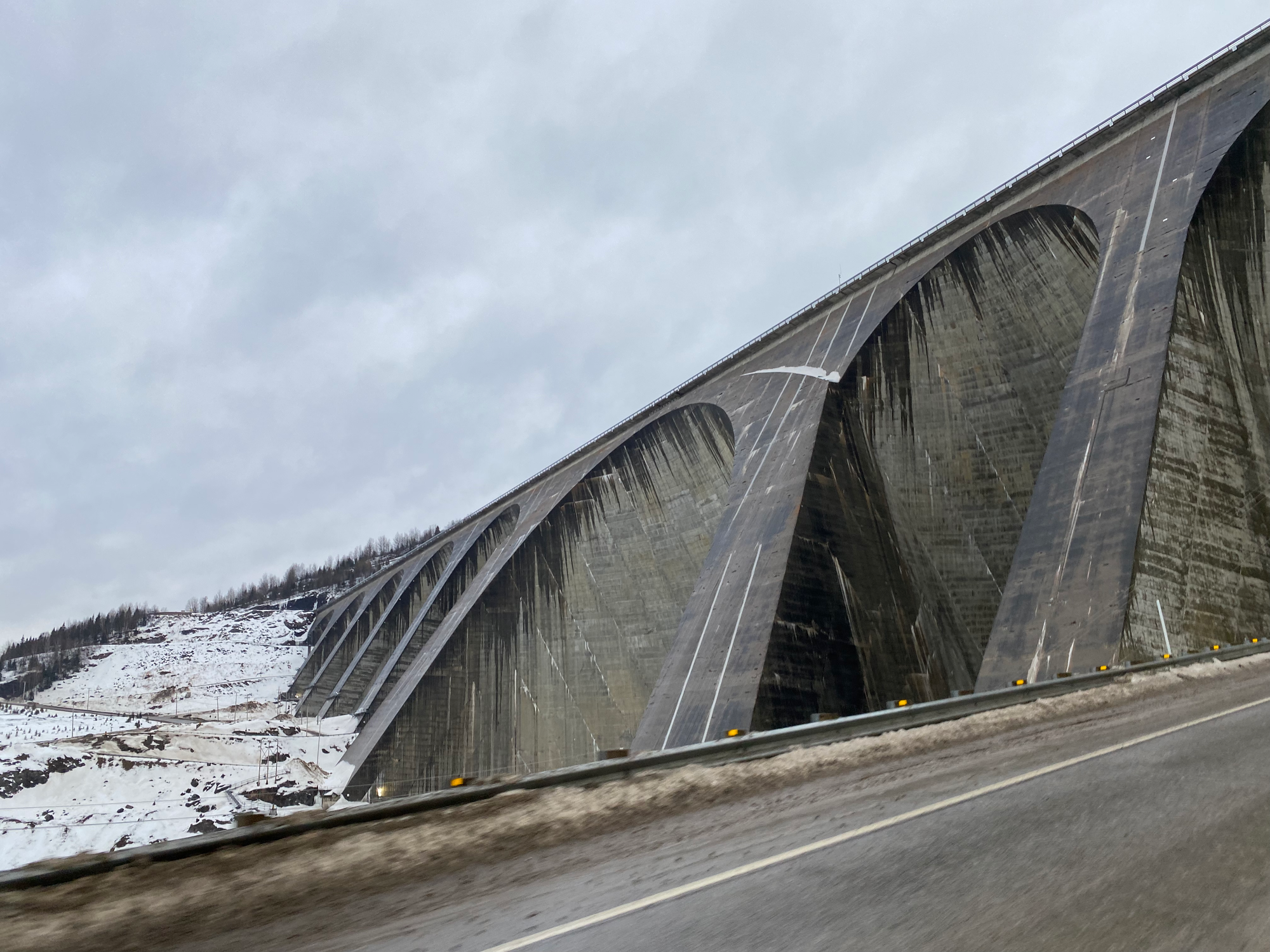
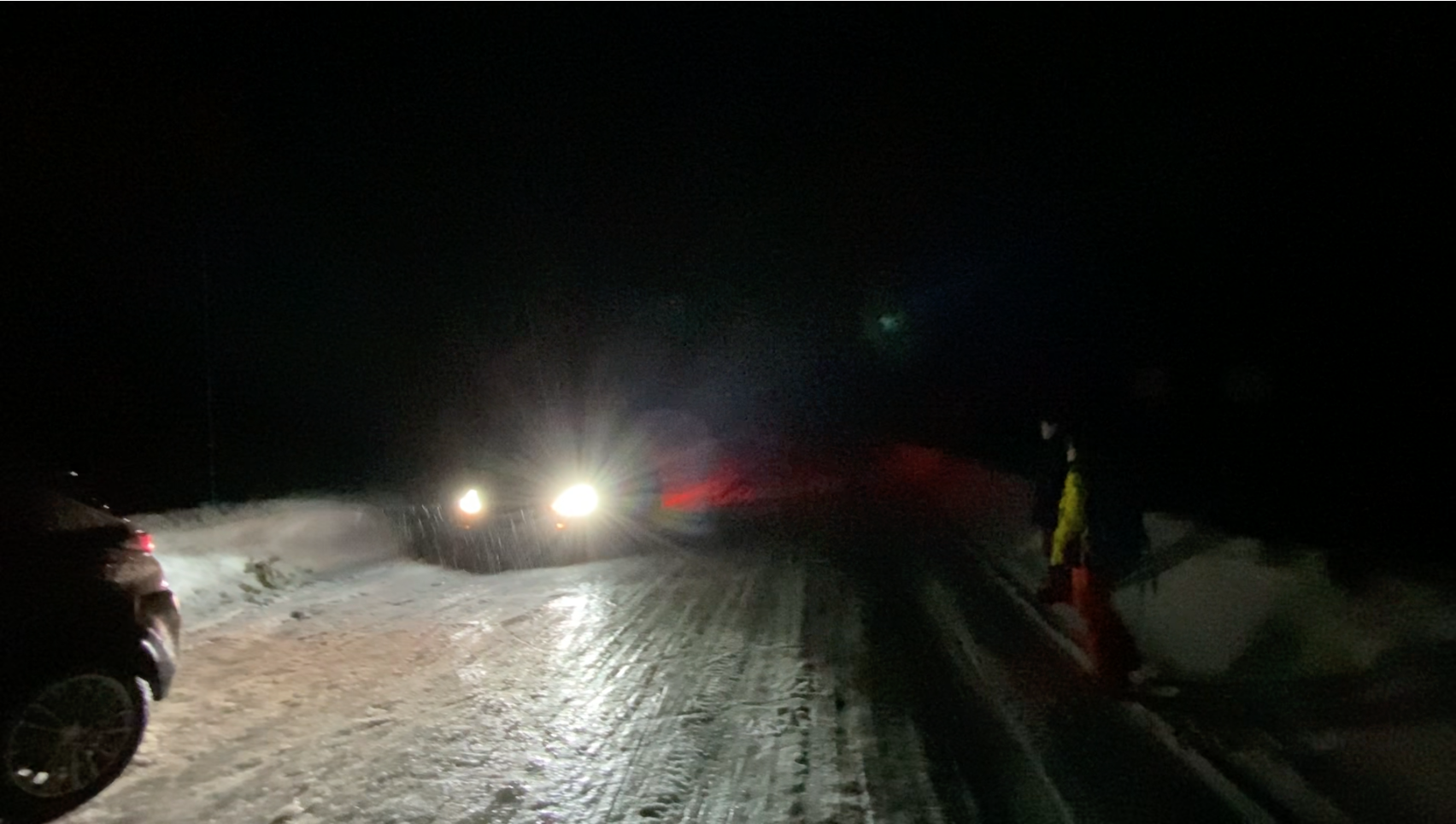
To help with the fuel problem, we built a fire (lighter fluid was helpful) and cooked some delicious tomato rice. Unfortunately someone left all our salt and seasoning in Montreal.
March 6, 2024
Another day at Manic-5. Today’s weather was pretty much perfect (sunny, just below 0 degrees) and we had a great time hanging out at our campsite. We built another campfire, toasted some bagels, skipped rocks on the ice, and explored the mouth of the Anita River. J. and R. tried to use a sharp rock to cut down a dead tree for a bench, and actually got pretty far. I was unaware of this when I walked up to the tree next to them, effortlessly breaking a few branches for firewood. I got some angry looks.
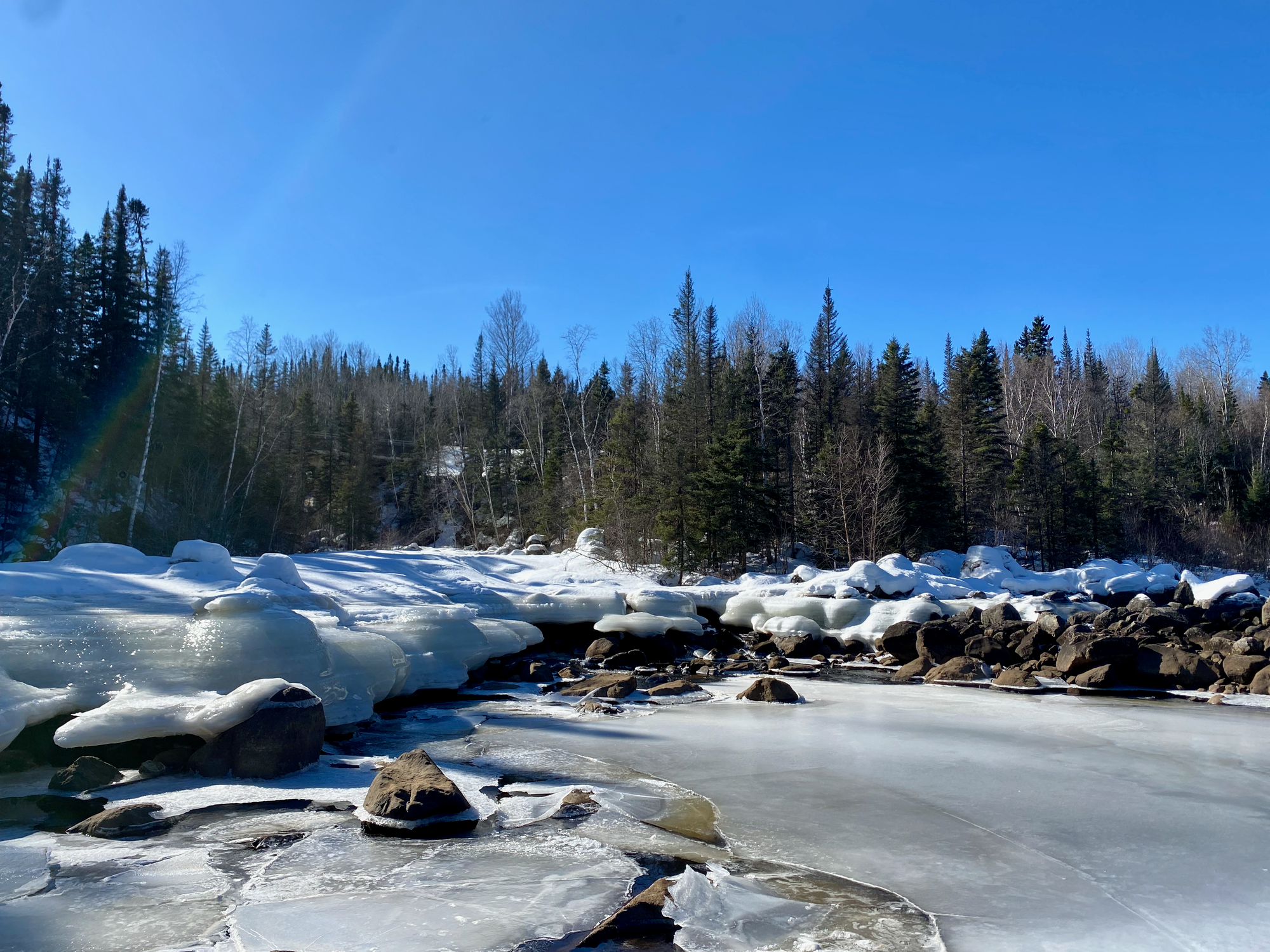

I took a few people on another gas station run. The cashier told us that conditions were improving on the road, and that we might be able to take our cars up there if we were careful, even the 2WD ones. This got my hopes up!
On the way back, we explored the area past the dam. The road switchbacks uphill then reaches a parking lot where the dam meets the hillside (unfortunately, the actual dam is gated off). A mound of snow provided our first view of the actual Manicouagan reservoir. We walked around the parking lot, unintentionally interrupting a meeting Y. and M. were having in the Tesla.
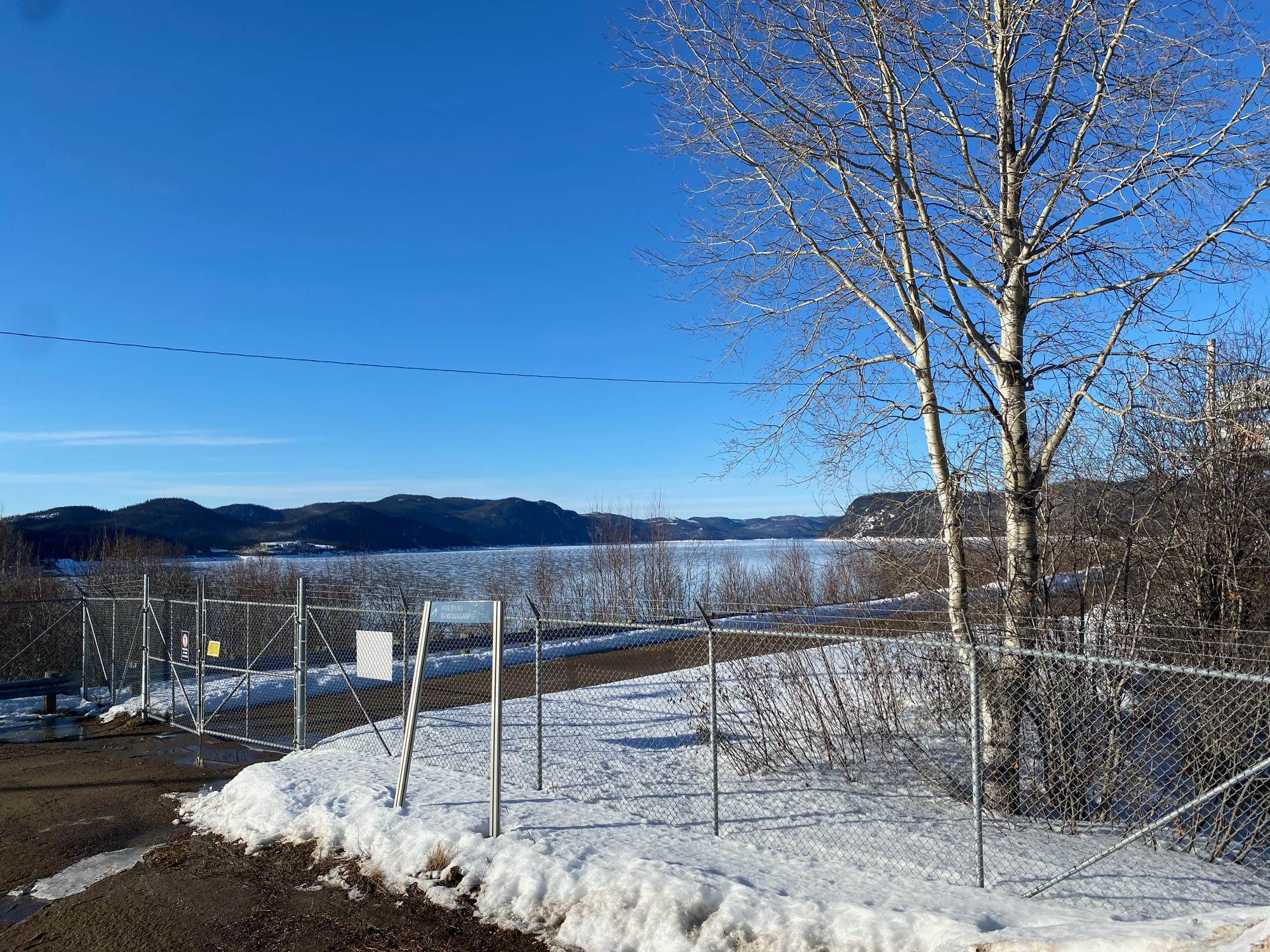
After a while we returned to our campsite, noticing that the water seemed a little higher than before. I scrambled down the coastline, passing W. and C. who were collecting firewood, and found a quiet spot to read my book and watch the ice break up…
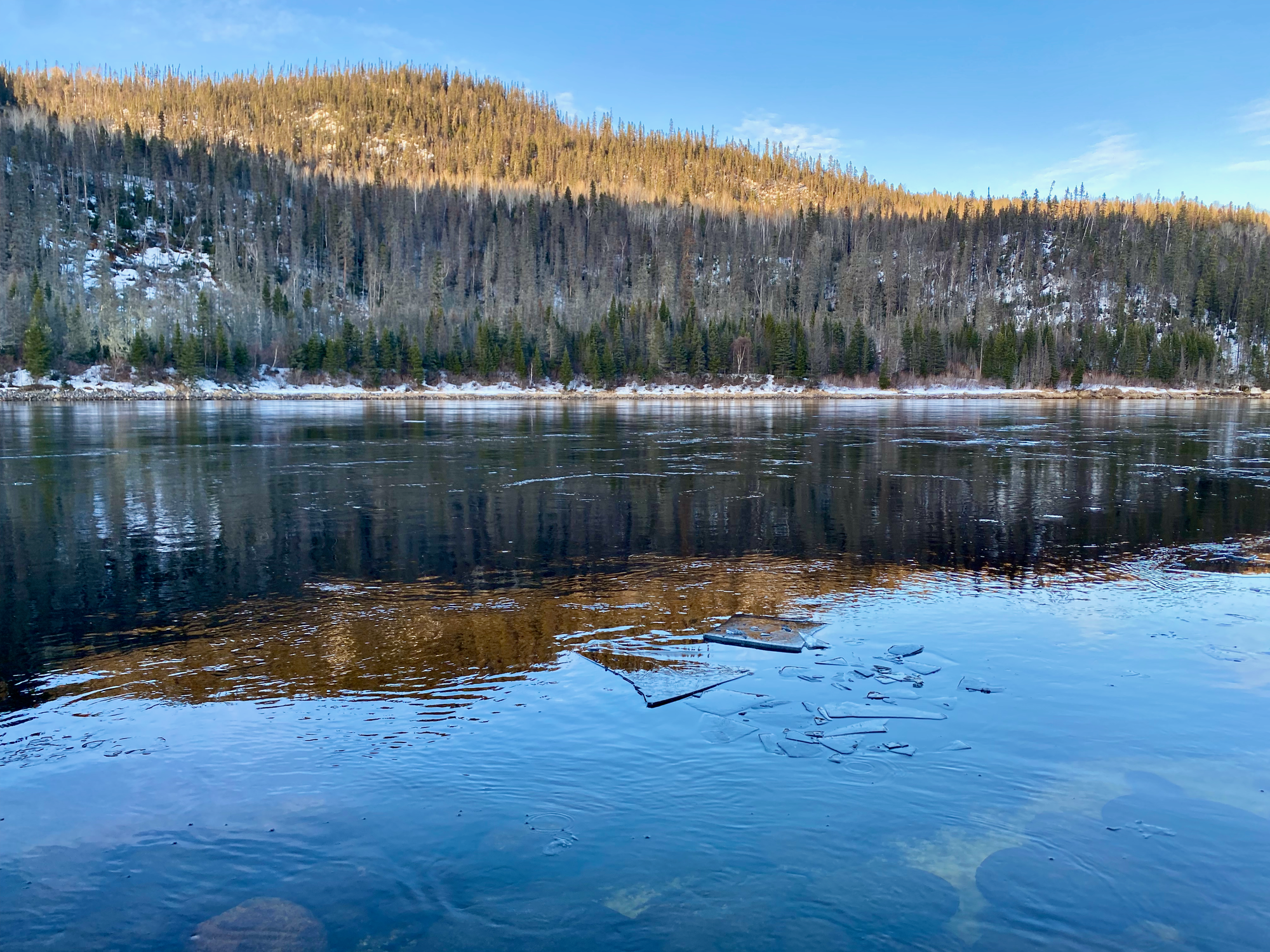
A couple chapters later, I looked up. The water was rising very quickly! I hurried back to camp, scrambling over the rocks before they were submerged. The flood didn’t stop, and W. , C., and I made it back to camp with seconds to spare.
Most of our food was piled by the shore in the path of the oncoming waters. Almost all hands were on deck as we moved everything to safety. As we rescued the last bags of dried fruits and frozen jam, water washed over the fire, sending all our hard work down the river.

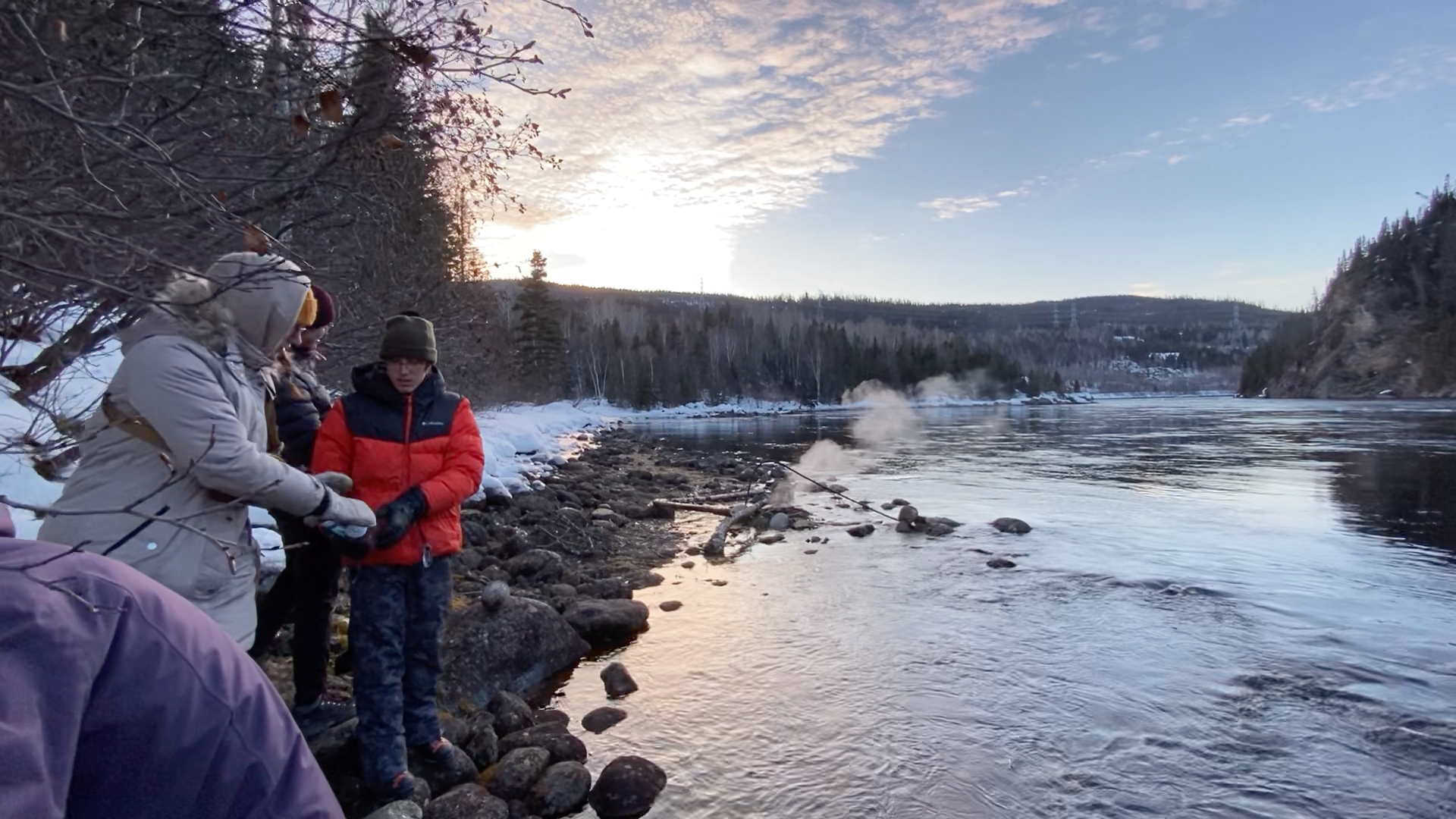
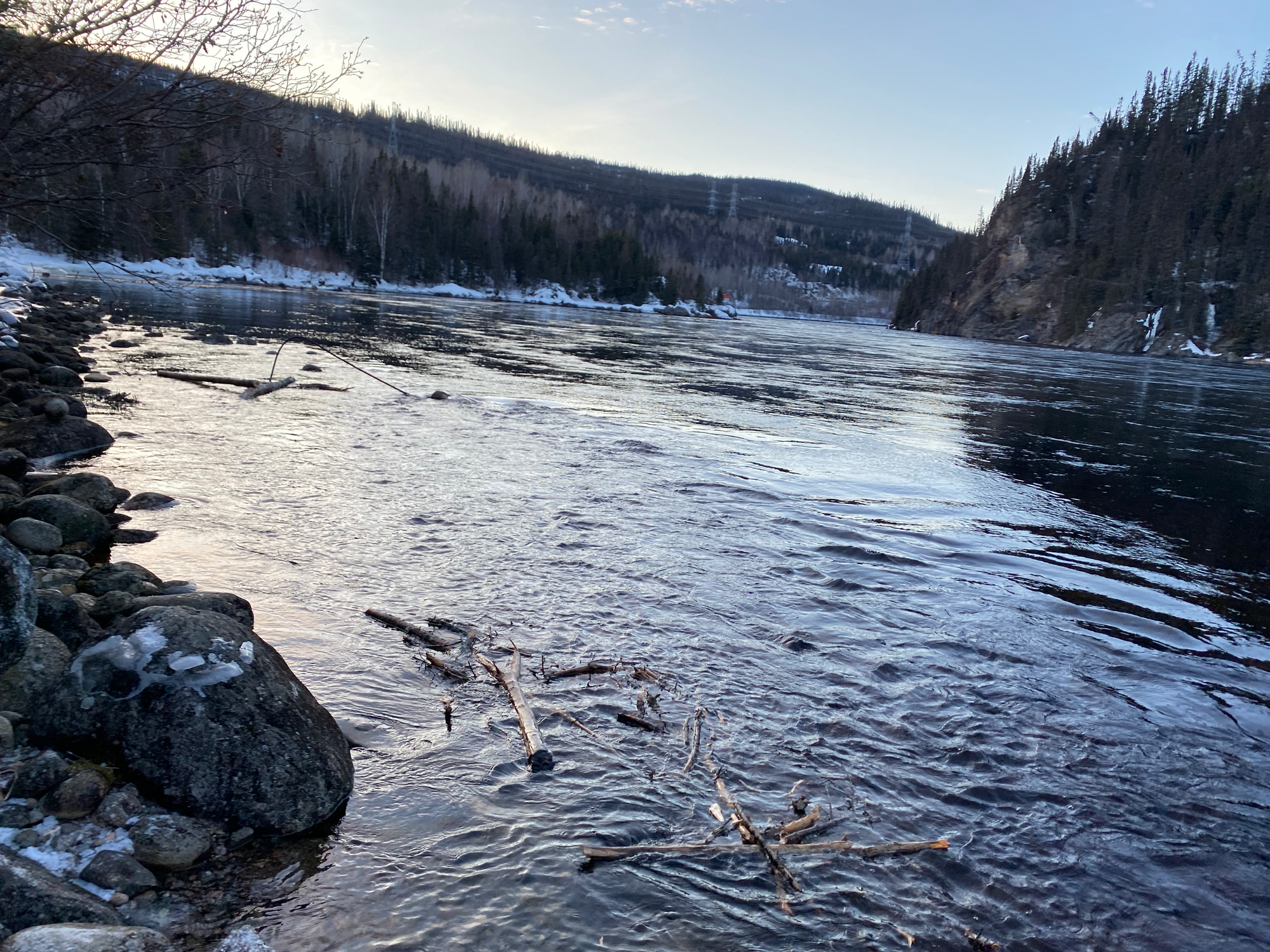
Luckily the tents were above the waterline and stayed dry, although the river came close to one. With no fire and limited propane, our best option for dinner was to build a new fire above the waterline. However, all four lighters were in the Tesla, which was nowhere to be found, so some of us started a rescue mission.
As the sun was setting, we located M. walking along the road. After some discussion we decided to just get dinner at the motel for the night. The waitress was not exactly enthusiastic about the prospect of serving 12 people but the food was satisfying, if expensive.
Some of us asked the cashier (the third one we’d met) about hitchhiking, getting D., the only Quebecer in the group, to translate. She told us that we were crazy for even considering abandoning our vehicles, the road had been salted and was in great shape, and that she herself had driven from Fermont in a 2WD vehicle that morning. It looked like we'd be able to drive after all!
When we returned to camp the water level had fallen to its lowest level yet. Somehow M.'s bench was still standing. Maybe it’s still there.

March 7, 2024
We woke up around 6:30 with the goal of leaving by 9:30. Several delays happened, including last-minute gas station runs and lost car keys, and we didn’t leave until 11:45. The joys of group travel.
We reported what we heard from the cashier last night, but the other drivers had met a ranger who drove the road two days earlier and had a hard time, so they still wanted to leave the cars and hitchhike. A few of us, including myself, wanted to bring at least some of the cars to the station - this would let us bring more supplies, and it would give us the freedom to shuttle people back to Manic-5 on the return journey on the 9th if some groups didn't get picked up. After some discussion we agreed on a plan. I would drive the rented car to the station, taking C., D., W., Z., and most of the supplies, while we left the Tesla and R.'s brother’s Kona at a parking lot past the dam. Everyone else would hitchhike and try to get to the station by nightfall. If the road was too dangerous to drive, I would return to Manic-5 and hitchhike from there. To open another line of communication, I contacted all the hitchhikers through inreach, so at least they could update when they reached the station.
We drove north. The road turned to gravel a few kilometres past the dam. The road crews had done their work; it was in good shape - better than any unpaved road I’ve driven in BC - and there were only a few avoidable ice patches. The dirt road returns to pavement just before the slightly post-apocalyptic outpost of Relais-Gabriel, where we pumped up the tires and ate some expensive hot dogs. Around 2:30pm we turned off the highway, navigated an icy access road, and arrived at the Station Uapishka. After a quick check-in, we still had enough time for a short hike, so off we went. After five days, our Monts Groulx adventure had finally begun!
The hitchhikers arrived at the station between 3 and 4 and let us know through the inreach. All was well for now.
See Part 2 for the rest of the trip.

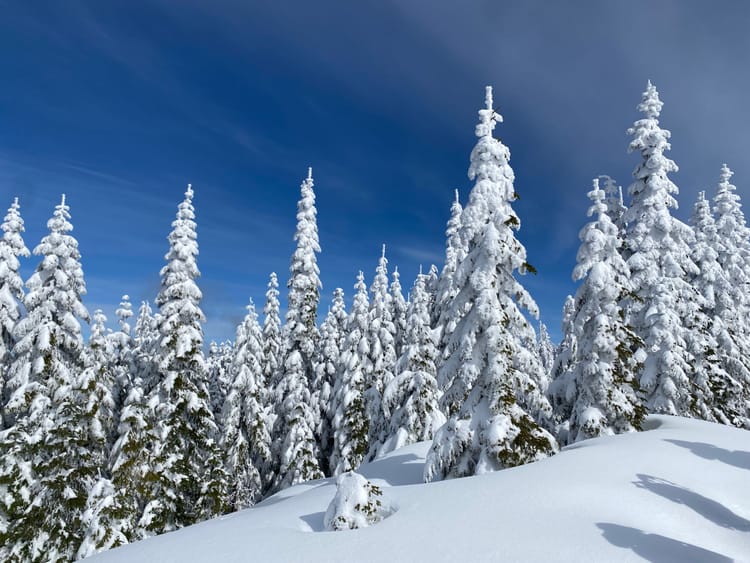

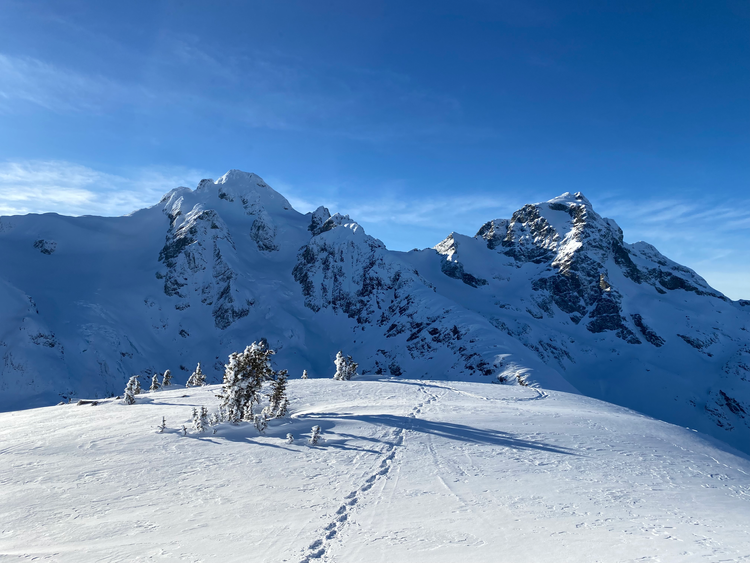
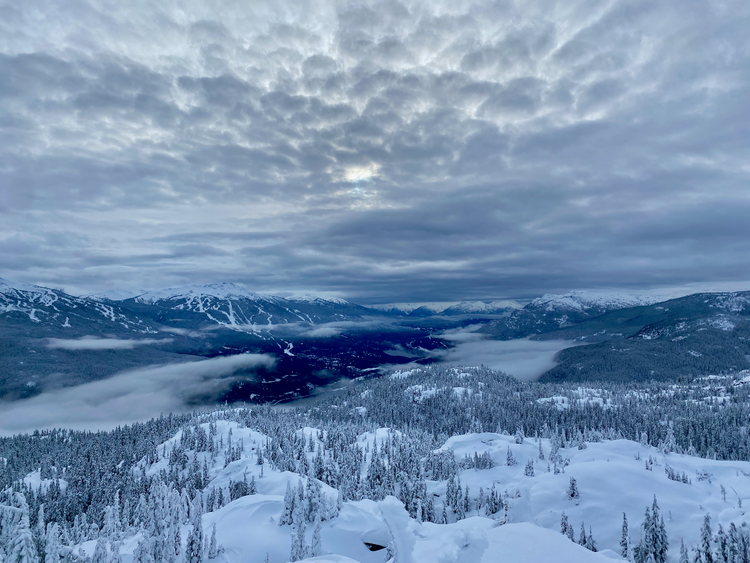
Member discussion